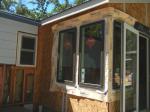Winter is around the corner. If you are planning to replace your old furnace make sure you size it correctly. A right size furnace can save you money and energy to run the system. The furnace also lasts longer.
Many HVAC (Heating Ventilation Air Conditioning) contractors use conventional rule of thumb to size furnaces and air conditioners: so many heating BTUs and so many cooling tons (1 ton = 12,000 BTUs) for so many square feet of space. However, houses are different and so the heating/cooling requirements are different. For a well sealed and well insulated home, 20,000-BTU heating and 1-ton cooling per 400 sq ft is usually oversized by a large margin.
Quite often the contractor oversizes both the furnace and air conditioner. The rationale is that if they provide more than the customer needs, the customer is not likely to complain about the house being too cold or too hot. There are several pitfalls of this argument. An oversized system runs less efficiently – the system turns on and off frequently, never allowing it to operate at a sustained and efficient level, and hence not most economically. Frequent on-off switchings wear the system out more quickly. Furthermore, a larger system generally costs more.
When you contact a HVAC contractor, ask if they use energy calculation tools, such as ACCA Manual J, to ascertain your heating and cooling requirement. If they don’t, find someone else who does the calculation. Or ask how they come up with the size. The energy calculation considers many parameters unique to a home, such as structural material of the home, air tightness of it, amount of insulation, and number and types of windows.
ACCA Manual J, or equivalent calculations, is required in California but has not been rigorously enforced in many jurisdictions. Fortunately, with the Energy Upgrade California programs, energy calculations must be performed and approved before rebates are given.
Do your homework before hiring a heating and cooling contractor. A properly sized system provides the optimal comfort and energy efficiency, and costs less to operate.








